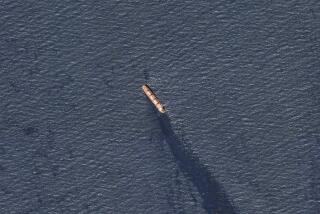Winds Hold Huge Oil Spill Off the Coast : Environment: ‘The weather has given us more time to get things in place,’ a U.S. Coast Guard spokesman says. But the threat persists.
- Share via
MANAMA, Bahrain — Heavy winds held back a huge oil spill in the Persian Gulf on Friday, giving emergency crews a few days’ time to deploy protective equipment aimed at saving key installations along Saudia Arabia’s coast.
A spokesman for the U.S. Coast Guard said the enormous slick has been pushed offshore by southerly winds, and “encroachment on the shoreline has not taken place as quickly as we had earlier feared.”
The spokesman said some estimates had suggested that the oil would reach the Saudi industrial city of Jubayl by Friday night, but now it is not expected to reach the area for another two days.
“The weather has given us more time to get things in place,” said the spokesman, Lt. Cmdr. Paul Milligan.
Abdullah Dabbagh, a Saudi oil expert with King Fahd University of Petroleum and Minerals, said that the oil slick was in about the same position as it was two days earlier.
“This does not remove the problem, but it gives us more breathing space and more time to set up protective equipment around threatened areas,” he said.
Dabbagh said one difference is that the spill, believed to be the worst in history, is beginning to break up into ribbons of oil several yards wide and more than a mile long. The breaking up of the spill has made it difficult for scientists to estimate the size, but earlier this week it was estimated to total 11 million barrels. There are 42 gallons to a barrel.
A second, smaller oil spill from an Iraqi facility in the northern Persian Gulf at Mina al Bakr was described as being four miles long and one mile wide by U.S. Army Brig. Gen. Pat Stevens IV at a military briefing in Riyadh on Friday. He said he had no details on where the slick was moving.
U.S. officials have accused the Iraqis of committing “environmental terrorism” by engineering the massive release of oil from an offshore Kuwaiti loading platform and five huge oil tankers moored off the Kuwaiti coast. Responding to the huge flow of oil, U.S. warplanes attacked the loading platform earlier this week, and it was later reported that the bombs had cut off the flow of oil.
Saudi officials said that the city of Jubayl, which contains much of Saudi Arabia’s petrochemical industry and its electricity generation and water desalination plants, had already been protected by two layers of flotation booms to keep oil from being sucked into the water intakes and ruining the vital installations.
There is no danger that desalination plants will have to be shut down, the officials said.
However, they noted that protective equipment such as booms and skimmers--huge pumps that remove the oil and deposit it on a barge--is in such scarce supply that there would be none available to protect wilderness areas or wildlife after strategic installations are guarded.
“It is a very sad situation, but there just isn’t enough equipment to do both jobs,” said one Saudi official.
The Saudis had planned to erect booms around islands where birds nest and to move coral reefs from the Gulf to the Red Sea.
Because of the shortage of equipment on the Saudi coast, Coast Guard spokesmen said they are using a north-south strategy, deploying booms and skimmers in northern areas and shifting that equipment southward as the slick moves down the coast. Booms and other equipment ordered on an emergency basis are expected to arrive soon to assist the protection efforts.
More to Read
Sign up for Essential California
The most important California stories and recommendations in your inbox every morning.
You may occasionally receive promotional content from the Los Angeles Times.










